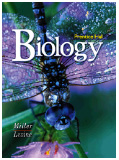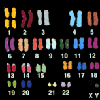BIOLOGY
by Miller & Levine
[complete Table of Contents]

|
Use the pull-down menu to jump to any of the Book's 40 Chapters: |
Additional Resources:
A
History of Genetics
(A great site with
copies of papers describing key experiments in the development of genetics
as a science)
The
Genetics Education Center
A great site (from the University of Kansas) with genetics education resources
and links to a host of useful web pages.
Classical
Genetics
A sensational web page that takes you through the basic principles of
genetics (from the Cold Spring Harbor Laboratory in Long Island)
History
of Genetics - Timeline
A detailed timeline depicting major events in the history of Genetics.
![]() Chapter 11
Chapter 11 ![]()
Introduction to Genetics
In this chapter, students will read about the principles of genetics and probability that determine how biological traits are inherited. They will also read about the process of meiosis and its importance in genetics.. The links below lead to additional resources to help you with this chapter. These include Hot Links to Web sites related to the topics in this chapter, the Take It to the Net activities referred to in your textbook, a Self-Test you can use to test your knowledge of this chapter, and Teaching Links that instructors may find useful for their students.
| Hot Links | Take it to the Net |
| Chapter Self-Test | Teaching Links |
What are Web Codes? |
Web
Codes for Chapter 11: Active Art: Meiosis Science News: Genetics SciLinks: Punnett Squares SciLinks: Mendelian Genetics SciLinks: Meiosis Self-Test |
![]()
Section
11-1: The Work of Gregor Mendel
![]() The principle
of dominance states that some alleles are dominant and others are recessive.
The principle
of dominance states that some alleles are dominant and others are recessive.
 When each F1 plant flowers, the two alleles
are segregated from each other so that each gamete carries only a single
copy of each gene. Therefore, each F1 plant produces two types of gametes—those
with the allele for tallness and those with the allele for shortness.
When each F1 plant flowers, the two alleles
are segregated from each other so that each gamete carries only a single
copy of each gene. Therefore, each F1 plant produces two types of gametes—those
with the allele for tallness and those with the allele for shortness.
Section
11-2: Probability and Punnett Squares
 The principles of probability can be
used to predict the outcomes of genetic crosses.
The principles of probability can be
used to predict the outcomes of genetic crosses.
Section
11-3: Exploring Mendelian Genetics
 The principle of independent assortment
states that genes for different traits can segregate independently during
the formation of gametes.
The principle of independent assortment
states that genes for different traits can segregate independently during
the formation of gametes.
 Some alleles are neither dominant nor
recessive, and many traits are controlled by multiple alleles or multiple
genes.
Some alleles are neither dominant nor
recessive, and many traits are controlled by multiple alleles or multiple
genes.
Section
11-4: Meiosis
 Meiosis is a process of reduction division
in which the number of chromosomes per cell is cut in half through the
separation of homologous chromosomes in a diploid cell.
Meiosis is a process of reduction division
in which the number of chromosomes per cell is cut in half through the
separation of homologous chromosomes in a diploid cell.
 Mitosis results in the production of
two genetically identical diploid cells, whereas meiosis produces four
genetically different haploid cells.
Mitosis results in the production of
two genetically identical diploid cells, whereas meiosis produces four
genetically different haploid cells.
Section
11-5: Linkage and Gene Maps
 The chromosomes assort independently;
individual genes do not.
The chromosomes assort independently;
individual genes do not.
A tutorial with problem sets, excellent graphics, and explanations of some of the most important principles of Mendelian genetics.
All About Genetics (with many links to other Genetics sites)
How many chromosomes does a dog have?
How about a cow, a chimp, or a pig?
Click here for the answers.
